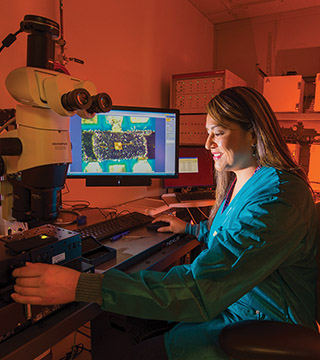
DEVICE AGING STUDIES — Rachelle Thompson (1356) inspects an electronic device that is part of a 30-year Sandia program that looks at how environments, including radiation from a nuclear weapon itself, could affect the performance of electronics inside a W76-1 warhead. The study begun in 2006 will provide real-time data for the first time on how electronics age within the weapon. (Photo by Randy Montoya)
Researchers at Sandia are studying how environments, including radiation that originates from a nuclear weapon itself, could affect the performance of electronics in the W76-1 warhead as they age.
Sandia, which is responsible for most non-nuclear components in US nuclear weapons, is helping replace W76 warheads in the nation’s stockpile with a refurbished version under the W76-1 Life Extension Program (LEP). The ballistic missile warhead is carried on the Trident II D5 missile aboard Ohio-class Navy submarines.
Researchers have studied radiation effects since the early days of nuclear weapons. But a 30-year program begun in 2006 will provide real-time data for the first time on how electronics age within the weapon. Studies in the past used techniques that artificially accelerated the aging process based on assumptions resulting from experiments and previous research.
“There has always been the question with accelerated aging data, how reliable is it?” says principal investigator Rachelle Thompson (1356).
The long-term project combines experiments, also known as physical simulation, with computational simulation and analysis. The approach developed as part of this project can be used in future LEPs, says manager Steve Wix (1356). Costs should be reduced for future stockpile surveillance and monitoring as well, since such lab-based studies cost less than accelerated aging techniques, which require using large environmental test facilities.
Study important in moving more toward predictive models
The project by Sandia’s Electrical Sciences Group 1350 is important for science-based stockpile stewardship because new electronic parts have been introduced into the W76-1 system since production began in 2008. The parts must function with assured reliability and performance throughout the life of the system. The project also is moving such evaluations toward more predictive models of aging for stockpile stewardship, Steve says. Stockpile stewardship assures the safety, security, and reliability of weapons in the absence of the underground nuclear tests the US halted in 1992.
The Commercial-Off-the-Shelf Electronics Component Engineering Dept. 2634 is collaborating on the study, which is sponsored by Stockpile Evaluation Dept. 2952 and is based on innovative technology developed by Kevin Horn in Radiation Effects Experimentation Dept. 1343.
Most of the experiments and analysis are done in a small laboratory full of racks of test and computer equipment and in an adjacent room packed with small test chambers, square white boxes that resemble miniature refrigerators. Each test chamber contains parts in a unique environment that is continually monitored to control temperature, relative humidity, and vibration frequency to ensure consistent levels of the multiple aging processes that will take decades. The experiments are overseen by test engineer Monica Espinosa.
Researchers develop and use advanced, physics-based computational simulations to predict how the electronics will perform as they age. They verify their predictions with experiments on the electronics to improve their understanding of the underlying physics engaged during the aging process. This research then guides further development of these critical simulation capabilities to resolve differences between the computer simulations and the aging experiments.
The researchers monitor thousands of devices that fall into six families of transistor and diode types. Hundreds are removed annually from the test chambers to determine their electrical performance under various operating conditions. The long-range test schedule was developed to assure that an adequate number of devices remain available for testing over the entire three decade-long study.
The parts under study were pristine when the project started eight years ago. Steve and Rachelle say no significant aging changes were expected in these early years, and what they have seen matches those predictions. Currently, only simple electrical devices are being tested, but researchers hope to add more complex parts later in the project.
Exposing devices to laser-based testing
Once the devices have aged in the predetermined storage environments, the team uses a sophisticated laser-based technique to expose each one to more hostile short-duration operating environments, Rachelle says.
Researchers take basic electrical measurements on aged transistors and diodes, then repackage them in preparation for evaluation with a benchtop laser-based simulated radiation environment source. They expose the parts to two different types of lasers: a broad beam that sweeps the entire device and a focused laser beam to expose it in specific areas. This process evaluates the performance of aged devices in more harsh environments. It takes up to 15 to 20 minutes for each test, and the project studies hundreds of parts per year, Rachelle says. “There is a lot of handling of parts and data analysis involved,” she says.
Unless the part is damaged or fails during testing, it goes back into the appropriate aging environment for future testing. The team evaluates each damaged or failed part to better understand the underlying cause.
The techniques Sandia is developing will help officials make future stockpile decisions based on an improved understanding of the impact of aging on how parts perform in multiple environments, Steve says.